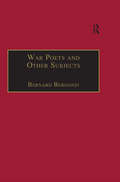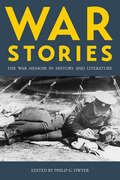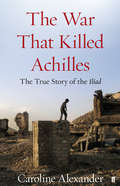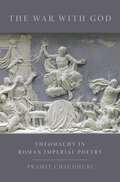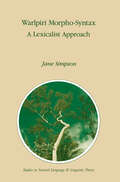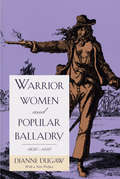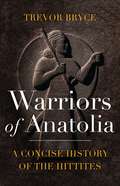- Table View
- List View
War Poets and Other Subjects
by Bernard BergonziIn the opening section of these related studies of modern literature, Bernard Bergonzi considers the poetry and fiction of two World Wars, including discussions of Wilfred Owen, Richard Aldington’s Death of a Hero, Pat Barker’s Regeneration, and the poetry of the Desert War of the 1940s. The second section deals with a number of prominent twentieth-century authors. Among other subjects, it looks at Ford Madox Ford’s The Good Soldier as a novel anticipating the Great War, the treatment of memory in Orwell’s Nineteen Eighty-Four, and aspects of the poetry of T.S. Eliot, responding to arguments about its anti-semitism. The final section is on Catholic writers, from Hopkins and Chesterton to Graham Greene and David Lodge. The book continues Bergonzi’s extensive career as a critic and literary historian of the modern period, and takes a fresh look at the subjects of some of the earlier books, such as Hopkins, Eliot, Wells, and the literature of war.
War Poets and Other Subjects
by Bernard BergonziIn the opening section of these related studies of modern literature, Bernard Bergonzi considers the poetry and fiction of two World Wars, including discussions of Wilfred Owen, Richard Aldington’s Death of a Hero, Pat Barker’s Regeneration, and the poetry of the Desert War of the 1940s. The second section deals with a number of prominent twentieth-century authors. Among other subjects, it looks at Ford Madox Ford’s The Good Soldier as a novel anticipating the Great War, the treatment of memory in Orwell’s Nineteen Eighty-Four, and aspects of the poetry of T.S. Eliot, responding to arguments about its anti-semitism. The final section is on Catholic writers, from Hopkins and Chesterton to Graham Greene and David Lodge. The book continues Bergonzi’s extensive career as a critic and literary historian of the modern period, and takes a fresh look at the subjects of some of the earlier books, such as Hopkins, Eliot, Wells, and the literature of war.
War Power: Literature and the State in the Civil War North (Oxford Studies in American Literary History)
by Philip GouldWhat happens if we reconsider the literature of the Civil War North in light of the transformation of the federal state's power? While literary scholarship about the Civil War has more generally focused on the rise of wartime nationalism, Philip Gould looks particularly at how literary works engage the subjects of censorship, propaganda, and the reconfigured meanings of "loyalty" and "treason" at a time of political crisis. During the war the Lincoln Administration shut down opposition newspapers and curtailed free expression and civil liberties protected by the US Constitution. Lincoln also suspended the writ of habeas corpus to deal with political dissenters and try to control public opinion. Early in the war, he coined the phrase "war power" to describe the (presumed) powers to address this crisis; his policies became controversial throughout the conflict. War Power: Literature and the State in the Civil War North considers literary production in this "total war" that radically changed the federal government's (and its military's) relation to traditional norms and spaces of private, domestic, and social life. Each chapter focuses on a major writer in the Civil War North's engagement with questions of identity, affect, and affiliation: Could one love the Union as one loved home and family? What were the implications for literary expression in the midst of a political culture being reshaped by censorship and propaganda? The final two chapters address the role and plight of African Americans in the Civil War and its aftermath, focusing particularly on African American military service as the supposed means by which racially disenfranchised Americans might become citizens.
War Stories: The War Memoir in History and Literature
by Philip DwyerAlthough war memoirs constitute a rich, varied literary form, they are often dismissed by historians as unreliable. This collection of essays is one of the first to explore the modern war memoir, revealing the genre’s surprising capacity for breadth and sophistication while remaining sensitive to the challenges it poses for scholars. Covering conflicts from the Napoleonic era to today, the studies gathered here consider how memoirs have been used to transmit particular views of war even as they have emerged within specific social and political contexts.
War Stories for Readers Theatre: World War II (Readers Theatre)
by Suzanne I. BarchersIn this book, ten scripts derived from highly regarded sources bring World War II to life for students in grades 6–12 and serve as a springboard for further investigation of this pivotal world event.World War II mobilized 100 million military personnel and resulted in the deadliest conflict in human history. Everyone from students in grade six to adults will be engrossed by tales documenting the actions of Hannah Szenes, a young Hungarian woman who lost her life trying to save Jews, the sobering and shocking occurrences during the Bataan Death March, and the daring POW rescues like the raid at Cabanatuan. Each script in War Stories for Readers Theatre: World War II not only brings history to life, but also provides a perspective that readers may not have encountered. While some topics are familiar, such as the attack on Pearl Harbor, most readers are unaware of the motivations behind it. Some of the narratives are created from interviews with living World War II veterans. Every reader will be inspired to explore each subject more deeply after experiencing these intimate views of the specific events during World War II.
The War That Killed Achilles: The True Story Of Homer's Iliad And The Trojan War
by Caroline AlexanderThe Iliad is still the greatest poem about war that our culture has ever produced. For a hundred generations, poets and thinkers in the West have pored over, retold and argued about the events described in this martial epic, even when direct knowledge of it was lost. Various empires have admired it as a book that in telling the story of the siege of Troy also extols the warrior ethic, and teaches the young how to die well.Yet the figure at the heart of the epic, the consummate warrior Achilles, is a brooding, controversial hero. He is a fierce critic of those who have started this war and allowed it to drag on, consuming soldiers and civilians alike. Disconcertingly, The Iliad portrays war as a catastrophe that destroys cities, orphans children and wrecks whole societies.Caroline Alexander's extraordinary book is not about any of the traditional concerns that have occupied classicists for centuries. It is simpler and more radical than that. In her words, 'This book is about what the Iliad is about; this book is about what the Iliad says of war.'
The War That Used Up Words: American Writers and the First World War
by Dr. Hazel HutchisonIn this provocative study, Hazel Hutchison takes a fresh look at the roles of American writers in helping to shape national opinion and policy during the First World War. From the war’s opening salvos in Europe, American writers recognized the impact the war would have on their society and sought out new strategies to express their horror, support, or resignation. By focusing on the writings of Henry James, Edith Wharton, Grace Fallow Norton, Mary Borden, Ellen La Motte, E. E. Cummings, and John Dos Passos, Hutchison examines what it means to be a writer in wartime, particularly in the midst of a conflict characterized by censorship and propaganda. Drawing on original letters and manuscripts, some never before seen by researchers, this book explores how the essays, poetry, and novels of these seven literary figures influenced America’s public view of events, from August 1914 through the Paris Peace Conference of 1919, and ultimately set the literary agenda for later, more celebrated texts about the war.
War, the Army and Victorian Literature
by J. PeckA ground-breaking study of how literature both reflected and contributed to the eclipse and subsequent revival of militarism in the nineteenth century. Focusing on four major disputes in the Crimea, India, the Sudan, and South Africa as well as the role of the army in Britain, John Peck examines how Victorian writers responded to military issues. At the heart of the book is a dilemma that characterises the Victorian period: the impossibility of reconciling imperial aggression with liberal domestic values.
War, the Hero and the Will: Hardy, Tolstoy and the Napoleonic Wars
by Jane L. BownasThomas Hardy's The Dynasts and Leo Tolstoy's War and Peace are both works which defy attempts to assign them to a particular genre but might seem to have little else in common apart from being set in the same period of history. This study argues that there are important similarities between these two works and examines the close correspondence between Hardy's and Tolstoy's thinking on themes relating to war, ideas of the heroic and the concept of free will. Although coming from very different backgrounds, both writers were influenced by their experiences of war, Tolstoy directly, by involvement in the wars in the Caucasus and the Crimea, and Hardy indirectly, by the events of the Anglo-Boer Wars. Their reaction to these experiences found expression in their descriptions of the wars fought against Napoleon at the beginning of the century. Hegel saw Napoleon as the great world-historical man of his time, and this work considers the ways in which Hardy and Tolstoy undermine this view, portraying Napoleon's physical and mental decline and questioning the role he played in determining the outcomes of military actions. Both writers were deeply interested in the question of free will and determinism and their writings reveal their attempts to understand the nature of the force which lies behind men's actions. Their differing views on the nature of consciousness are considered in the light of modern research on the development of the conscious brain.
War, the Hero and the Will: Hardy, Tolstoy and the Napoleonic Wars
by Jane BownasThomas Hardy's The Dynasts and Leo Tolstoy's War and Peace are both works which defy attempts to assign them to a particular genre but might seem to have little else in common apart from being set in the same period of history. This study argues that there are important similarities between these two works and examines the close correspondence between Hardy's and Tolstoy's thinking on themes relating to war, ideas of the heroic and the concept of free will. Although coming from very different backgrounds, both writers were influenced by their experiences of war, Tolstoy directly, by involvement in the wars in the Caucasus and the Crimea, and Hardy indirectly, by the events of the Anglo-Boer Wars. Their reaction to these experiences found expression in their descriptions of the wars fought against Napoleon at the beginning of the century. Hegel saw Napoleon as the great world-historical man of his time, and this work considers the ways in which Hardy and Tolstoy undermine this view, portraying Napoleon's physical and mental decline and questioning the role he played in determining the outcomes of military actions. Both writers were deeply interested in the question of free will and determinism and their writings reveal their attempts to understand the nature of the force which lies behind men's actions. Their differing views on the nature of consciousness are considered in the light of modern research on the development of the conscious brain.
War Trauma and English Modernism: T. S. Eliot and D. H. Lawrence
by C. KrockelThis is the first book to consistently read English Modernist literature as testimony to trauma of the First and Second World Wars. Focusing upon T.S. Eliot and D.H. Lawrence, it examines the impact of war upon their lives and their strategies to resist it through literary innovation.
Warlpiri Morpho-Syntax: A Lexicalist Approach (Studies in Natural Language and Linguistic Theory #23)
by J. SimpsonThe Warm South: How the Mediterranean Shaped the British Imagination
by Robert HollandAn evocative exploration of the impact of the Mediterranean on British culture, ranging from the mid-eighteenth century to today Ever since the age of the Grand Tour in the eighteenth century, the Mediterranean has had a significant pull for Britons—including many painters and poets—who sought from it the inspiration, beauty, and fulfillment that evaded them at home. Referred to as “Magick Land” by one traveler, dreams about the Mediterranean, and responses to it, went on to shape the culture of a nation. Written by one of the world’s leading historians of the Mediterranean, this book charts how a new sensibility arose from British engagement with the Mediterranean, ancient and modern. Ranging from Byron’s poetry to Damien Hirst’s installations, Robert Holland shows that while idealized visions and aspirations often met with disillusionment and frustration, the Mediterranean also offered a notably insular society the chance to enrich itself through an imagined world of color, carnival, and sensual self-discovery.
Warning Signs: The Semiotics of Danger (Bloomsbury Advances in Semiotics)
by Marcel DanesiWarning signs are all around us. In ancient Egypt, tombs were lavishly adorned with signs and symbols warning of the dire consequences that would befall any robbers and thieves. And yet these signs were often read as provocations and challenges. Why was this? And how could we more effectively communicate dangers from our world, such as toxic waste, to future civilizations?This book examines and evaluates the kinds of signs, symbols, narratives and other semiotic strategies humans have used across time to communicate the sense of danger. From paleolithic cave art and ancient monuments to the dangers of nuclear waste, carbon emissions and other pollution, Marcel Danesi explores how danger has been encoded in language, discourse, and symbolism. At the same time, the book puts forward a plan for a more effective 'semiotising' of risk and peril, calling on linguists, semioticians and agencies to face up our collective responsibilities, and work together to more clearly communicate vitally important warnings about the dangers we've left behind to civilizations beyond the semiotic gap.
Warning Signs: The Semiotics of Danger (Bloomsbury Advances in Semiotics)
by Marcel DanesiWarning signs are all around us. In ancient Egypt, tombs were lavishly adorned with signs and symbols warning of the dire consequences that would befall any robbers and thieves. And yet these signs were often read as provocations and challenges. Why was this? And how could we more effectively communicate dangers from our world, such as toxic waste, to future civilizations?This book examines and evaluates the kinds of signs, symbols, narratives and other semiotic strategies humans have used across time to communicate the sense of danger. From paleolithic cave art and ancient monuments to the dangers of nuclear waste, carbon emissions and other pollution, Marcel Danesi explores how danger has been encoded in language, discourse, and symbolism. At the same time, the book puts forward a plan for a more effective 'semiotising' of risk and peril, calling on linguists, semioticians and agencies to face up our collective responsibilities, and work together to more clearly communicate vitally important warnings about the dangers we've left behind to civilizations beyond the semiotic gap.
Warped Mourning: Stories of the Undead in the Land of the Unburied (Cultural Memory in the Present #440)
by Alexander EtkindAfter Stalin's death in 1953, the Soviet Union dismantled the enormous system of terror and torture that he had created. But there has never been any Russian ban on former party functionaries, nor any external authority to dispense justice. Memorials to the Soviet victims are inadequate, and their families have received no significant compensation. This book's premise is that late Soviet and post-Soviet culture, haunted by its past, has produced a unique set of memorial practices. More than twenty years after the collapse of the Soviet Union, Russia remains "the land of the unburied": the events of the mid-twentieth century are still very much alive, and still contentious. Alexander Etkind shows how post-Soviet Russia has turned the painful process of mastering the past into an important part of its political present.
Warrior Women and Popular Balladry, 1650-1850 (Cambridge Studies In Eighteenth-century English Literature And Thought Ser. #4)
by Dianne DugawThis interdisciplinary study uncovers a fascination with women cross dressers in the popular literature of early modern Britain, in a wide range of texts from popular ballads and chapbook life histories to the comedies and tragedies of aristocratic literature. Dugaw demonstrates the extent to which gender and sexuality are enacted as constructs of history.
The Warrior Women of Islam: Female Empowerment in Arabic Popular Literature (Library Of Middle East History Ser.)
by Remke KrukColloquial Arabic storytelling is most commonly associated with the Arabian Nights. But few people are aware of a much larger corpus of narrative texts known as popular epic. These heroic romantic tales, originating in the Middle Ages, form vast cycles of adventure stories whose most remarkable feature is their portrayal of powerful and memorable women. Wildly appreciated by medieval audiences, and spread by professional storytellers throughout the cities of the Muslim world, this material was printed and reprinted over the centuries and remains a vital part of Arab culture. Yet virtually none is available in translation, and so remains almost unknown to a non-Arab public. Remke Kruk at last makes these neglected romances available to a Western audience. She recounts the story of Princess Dhat al-Himma, brave and undefeated leader of the Muslim army in its wars against the Byzantines; of Ghamra, brought up as a boy to become a fearless leader of men; and of Qannasa, an infidel, raiding from her mountain fortress to capture and seduce her enemies before putting them pitilessly to the sword. The Warrior Women of Islam puts a bold new complexion on gender roles and the wider perception of women in the Middle East.
Warriors of Anatolia: A Concise History of the Hittites
by Trevor BryceThe Hittites in the Late Bronze Age became the mightiest military power in the Ancient Near East. Yet their empire was always vulnerable to destruction by enemy forces; their Anatolian homeland occupied a remote region, with no navigable rivers; and they were cut off from the sea. Perhaps most seriously, they suffered chronic under-population and sometimes devastating plague. How, then, can the rise and triumph of this ancient imperium be explained, against seemingly insuperable odds? In his lively and unconventional treatment of one of antiquity's most mysterious civilizations, whose history disappeared from the records over three thousand years ago, Trevor Bryce sheds fresh light on Hittite warriors as well as on the Hittites' social, religious and political culture and offers new solutions to many unsolved questions. Revealing them to have been masters of chariot warfare, who almost inflicted disastrous defeat on Rameses II at the Battle of Qadesh (1274 BCE), he shows the Hittites also to have been devout worshippers of a pantheon of storm-gods and many other gods, and masters of a new diplomatic system which bolstered their authority for centuries.Drawing authoritatively both on texts and on ongoing archaeological discoveries, while at the same time offering imaginative reconstructions of the Hittite world, the author argues that while the development of a warrior culture was essential, not only for the Empire's expansion but for its very survival, this by itself was not enough. The range of skills demanded of the Hittite ruling class went way beyond mere military prowess, while there was much more to the Hittites themselves than just skill in warfare. This engaging volume reveals the Hittites in their full complexity, including the festivals they celebrated; the temples and palaces they built; their customs and superstitions; the crimes they committed; their social hierarchy, from king to slave; and the marriages and pre-nuptial agreements they contracted. It takes the reader on a journey which combines epic grandeur, spectacle and pageantry with an understanding of the intimacies and idiosyncrasies of Hittite daily life.
Warriors of Anatolia: A Concise History of the Hittites
by Trevor BryceThe Hittites in the Late Bronze Age became the mightiest military power in the Ancient Near East. Yet their empire was always vulnerable to destruction by enemy forces; their Anatolian homeland occupied a remote region, with no navigable rivers; and they were cut off from the sea. Perhaps most seriously, they suffered chronic under-population and sometimes devastating plague. How, then, can the rise and triumph of this ancient imperium be explained, against seemingly insuperable odds? In his lively and unconventional treatment of one of antiquity's most mysterious civilizations, whose history disappeared from the records over three thousand years ago, Trevor Bryce sheds fresh light on Hittite warriors as well as on the Hittites' social, religious and political culture and offers new solutions to many unsolved questions. Revealing them to have been masters of chariot warfare, who almost inflicted disastrous defeat on Rameses II at the Battle of Qadesh (1274 BCE), he shows the Hittites also to have been devout worshippers of a pantheon of storm-gods and many other gods, and masters of a new diplomatic system which bolstered their authority for centuries.Drawing authoritatively both on texts and on ongoing archaeological discoveries, while at the same time offering imaginative reconstructions of the Hittite world, the author argues that while the development of a warrior culture was essential, not only for the Empire's expansion but for its very survival, this by itself was not enough. The range of skills demanded of the Hittite ruling class went way beyond mere military prowess, while there was much more to the Hittites themselves than just skill in warfare. This engaging volume reveals the Hittites in their full complexity, including the festivals they celebrated; the temples and palaces they built; their customs and superstitions; the crimes they committed; their social hierarchy, from king to slave; and the marriages and pre-nuptial agreements they contracted. It takes the reader on a journey which combines epic grandeur, spectacle and pageantry with an understanding of the intimacies and idiosyncrasies of Hittite daily life.
Warriors' Wives: Ancient Greek Myth and Modern Experience
by Dr Emma BridgesEpic poetry and tragic drama provide us with some of the richest ancient Greek depictions of women who are married to soldiers. In tales of the Trojan War, as told by Homer, Aeschylus, Sophocles, and Euripides, we encounter these mythical warriors' wives: Penelope, isolated but resourceful as she awaits the return of Odysseus after his lengthy absence; the war widow Andromache, enslaved and displaced from her homeland after the fall of Troy; the unfaithful and murderous Clytemnestra; and Tecmessa, a war captive who witnesses her partner's breakdown and suicide in the aftermath of battle. Warriors' Wives compares the experiences of these mythical characters with those of contemporary military spouses. Emma Bridges traces aspects of the lives of warriors' wives—mythical and real, ancient and modern—from the moment of farewell, through periods of separation and reunion, to the often traumatic aftermath of war, to consider the emotional, psychological, and social impacts of life as a military spouse. By unearthing a wealth of contemporary evidence for the lives of the often silenced and unacknowledged partners of those who serve in the military, and by examining this alongside the ancient stories of warriors' wives, Warriors' Wives sheds fresh light on the experience of being married to the military.
Warriors' Wives: Ancient Greek Myth and Modern Experience
by Dr Emma BridgesEpic poetry and tragic drama provide us with some of the richest ancient Greek depictions of women who are married to soldiers. In tales of the Trojan War, as told by Homer, Aeschylus, Sophocles, and Euripides, we encounter these mythical warriors' wives: Penelope, isolated but resourceful as she awaits the return of Odysseus after his lengthy absence; the war widow Andromache, enslaved and displaced from her homeland after the fall of Troy; the unfaithful and murderous Clytemnestra; and Tecmessa, a war captive who witnesses her partner's breakdown and suicide in the aftermath of battle. Warriors' Wives compares the experiences of these mythical characters with those of contemporary military spouses. Emma Bridges traces aspects of the lives of warriors' wives—mythical and real, ancient and modern—from the moment of farewell, through periods of separation and reunion, to the often traumatic aftermath of war, to consider the emotional, psychological, and social impacts of life as a military spouse. By unearthing a wealth of contemporary evidence for the lives of the often silenced and unacknowledged partners of those who serve in the military, and by examining this alongside the ancient stories of warriors' wives, Warriors' Wives sheds fresh light on the experience of being married to the military.
Warsaw Tales (City Tales)
by Helen Constantine Antonia Lloyd-JonesWarsaw Tales is an anthology of short stories and non-fiction set in the Polish capital. Beginning in 1911 with Boleslaw Prus' Apparitions, the collected stories provide a chronological account of the city's tumultuous and dramatic history. Each story captures a phase of Warsaw's past, through the interwar period as a Polish republic, the Second World War and the city's Nazi occupation, the post-war city in ruins and its rebuilding under the communist regime, and its new status as the capital of an independent Poland in 1989. With each story set in a specific part of the city, the collection becomes a guidebook to Warsaw's temporal, spatial, and psychological geography. This collection features a wide variety of authors including Boleslaw Prus, Maria Kuncewiczowa, Jaroslaw Iwaszkiewicz, Ludwik Hering, Zofia Petersowa, Marek Hlasko, Kazimierz Orlos, Hanna Krall, Antoni Libera, Zbigniew Mentzel, Olga Tokarczuk, and Krzysztof Varga.
Warsaw Tales (City Tales)
Warsaw Tales is an anthology of short stories and non-fiction set in the Polish capital. Beginning in 1911 with Boleslaw Prus' Apparitions, the collected stories provide a chronological account of the city's tumultuous and dramatic history. Each story captures a phase of Warsaw's past, through the interwar period as a Polish republic, the Second World War and the city's Nazi occupation, the post-war city in ruins and its rebuilding under the communist regime, and its new status as the capital of an independent Poland in 1989. With each story set in a specific part of the city, the collection becomes a guidebook to Warsaw's temporal, spatial, and psychological geography. This collection features a wide variety of authors including Boleslaw Prus, Maria Kuncewiczowa, Jaroslaw Iwaszkiewicz, Ludwik Hering, Zofia Petersowa, Marek Hlasko, Kazimierz Orlos, Hanna Krall, Antoni Libera, Zbigniew Mentzel, Olga Tokarczuk, and Krzysztof Varga.
